Human Resource Management of MTC
Employees are regarded as the core driving force of the organization. The company is committed to managing its human resources to ensure that employees possess expertise in their respective fields, are well-suited for their positions, and are supported in achieving their desired career growth. The company applies clear and fair selection criteria that consider candidates’ competencies, ethics, attitudes toward work, and ability to collaborate with others, while promoting gender equality and non-discrimination as part of its human rights principles. The company is also dedicated to creating and expanding equal opportunities for all employees, fostering an inclusive organizational culture built on acceptance, respect, and equal participation, and supporting women’s representation on the Board of Directors and their significant role in corporate management.
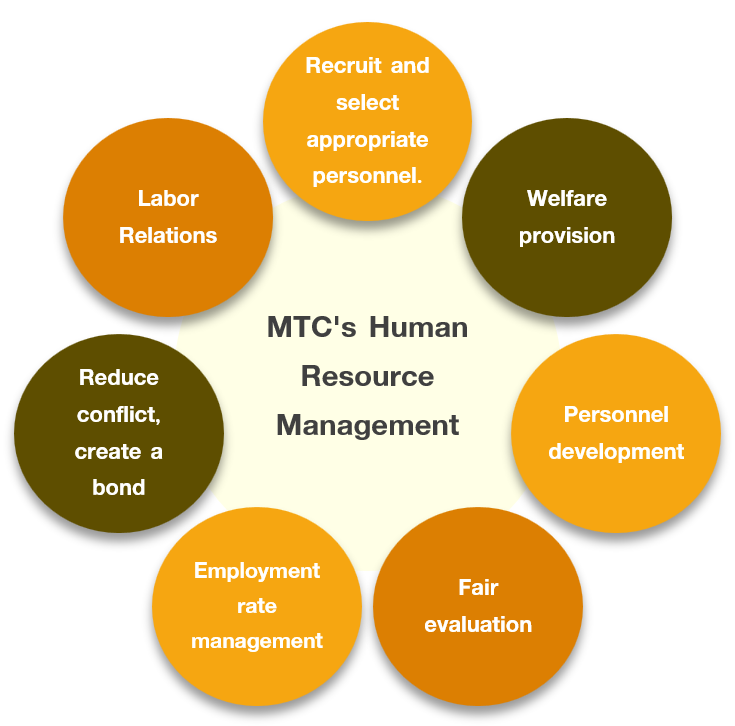
1. Human Resource Recruitment and Labor Management Process
Employees are the key driving force behind the company’s business operations. Therefore, the recruitment and selection of personnel are crucial processes that significantly influence the organization’s overall performance and success. The company’s recruitment and selection process is carried out as follows:
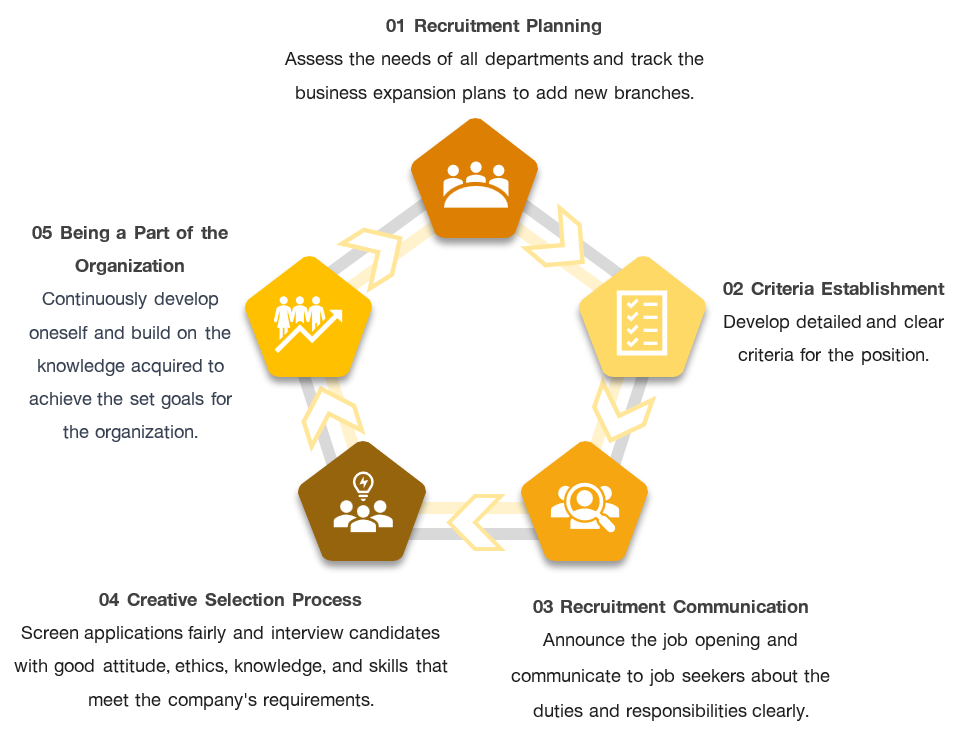
1.1 Recruitment Planning
The company surveys the required workforce within the organization, understanding the structure and operational strategies of each department. This includes evaluating qualifications, expertise, job responsibilities, and necessary experience. Additionally, the company tracks plans for new branch openings or future business expansions to assess and strategize recruitment efforts effectively. Moreover, it designs selection processes tailored to meet the organization's needs and ensure efficient and sustainable business operations.
1.2 Criteria Establishment
The company establishes employee qualification criteria, specifying the necessary skills for each position in detail. This includes defining required knowledge levels, abilities, and suitable personal characteristics such as leadership, responsibility, and teamwork skills. Furthermore, it sets standards for measuring and evaluating applicants' performance to assess their readiness and suitability for the job. These standards help streamline the selection process and maximize efficiency.
1.3 Recruitment communication
The company systematically announces job openings through reliable channels such as our website, job boards, and online social media platforms. This increases opportunities for applicants to access job information, with clear details provided to ensure a thorough understanding of job requirements, responsibilities, salary levels, and comprehensive benefits. This approach enhances professionalism and instills confidence in applicants, while also communicating information about the company's business, values, and organizational culture to attract candidates who are genuinely interested in joining.
1.4 Creative Selection Process
The Company is committed to conducting a fair and systematic recruitment process to select individuals with the qualifications and potential best suited for each position. The selection process carefully considers candidates’ qualifications, skills, attitudes, and ethics through interviews and job-specific assessments to ensure that the recruited personnel align with the Company’s organizational goals.
Furthermore, the Company places great importance on local employment, providing equal opportunities for people in the communities where it operates. This approach helps generate stable income for local residents, fosters a workforce that understands the local context, and supports the sustainable growth of both the Company and the communities it serves.
In addition, the Company promotes youth development through internship and graduate trainee programs, offering university students and recent graduates the opportunity to gain hands-on experience in various professional fields. These programs help prepare young talents for the labor market and nurture future professionals who can grow alongside the organization.
1.5 Being a Part of the Organization
Employees must align with the organization's vision, understanding our goals, strategies, and culture. They should also participate in the organization's development to help and improve our operations. Furthermore, self-development and knowledge advancement are crucial. In an era of rapid change, accumulating new knowledge and skills and being proactive in self-development will help the organization become stronger and grow continuously.
2. Employee Welfare and Benefits
To motivate employees to work effectively, the company provides various benefits and privileges, such as free accommodation, medical insurance, and 98 days of parental leave per year. This is to reward their hard work, reduce the burden of living costs, and allow them to work without worry. The company also promotes health care by providing a standard fitness center for employees, a medical room with medical equipment and medicines, and annual health checkups. To maintain good relationships between employees, the company organizes internal bonding activities, social events, and regular leisure travel to reduce stress that may occur from working for long hours. The company also encourages employees to save money through a provident fund and provides legal compensation to employees who have worked for at least 20 years and 1 day. This is to ensure that employees have a reserve of money to spend in the future or to cover the cost of emergency loans.

Employees are also encouraged to participate in proposing desired benefits and welfare programs through the Welfare Committee and various company communication channels, such as the Z-Thai website, internal departmental meetings, and the employee satisfaction survey. In 2024, the Welfare Committee held one official meeting to provide employees with an opportunity to express their opinions and suggestions. Key agenda items included reviewing daily wage compensation to ensure compliance with legal requirements and proposing the organization of a fire evacuation training course for employees.
3. Training and Development
The company places great importance on the development of its employees to ensure preparedness for change, enhance work efficiency, and support career advancement. Providing employee training is therefore essential for the organization’s continued growth and success. In 2024, the company provided an average of 11.77 training hours per employee, totaling over 187,000 training hours, covering employees at all levels nationwide, with eight training programs conducted throughout the year. In addition, more than 80% of employees successfully passed post-training assessments in nearly all programs, exceeding the company’s target. The company’s training topics are as follows:
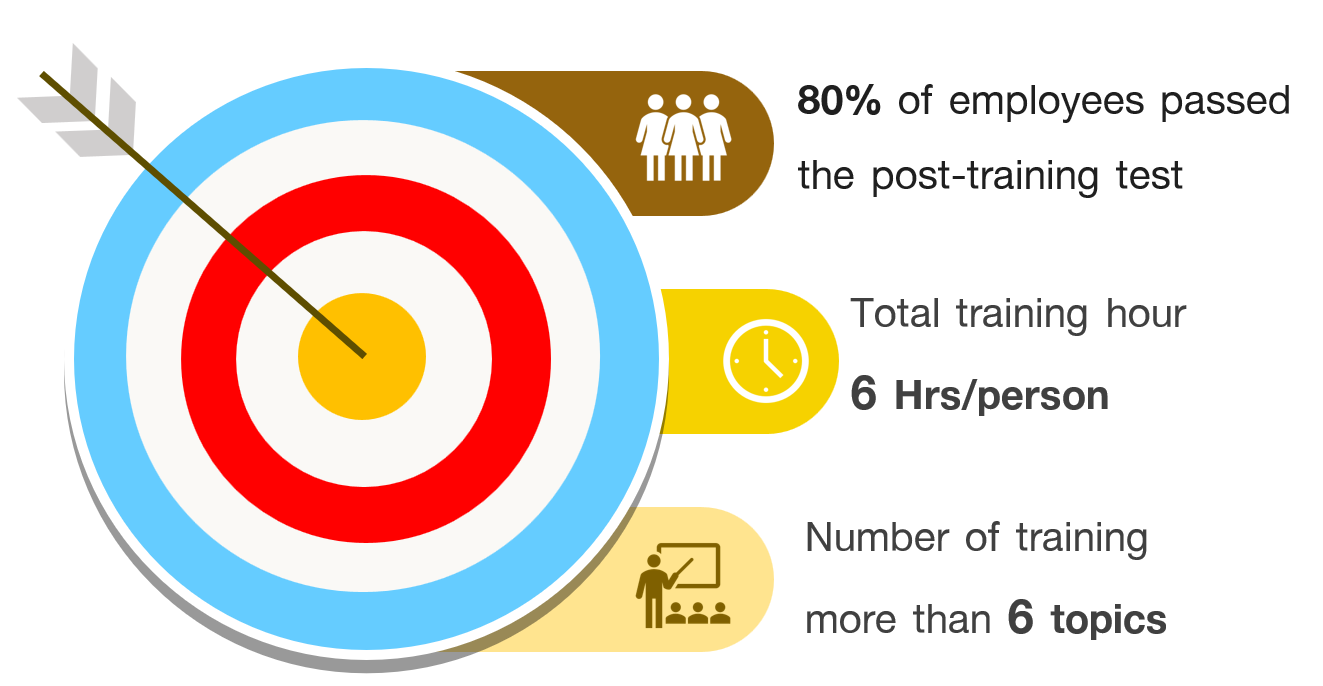
| Topic | Hrs / Person | Number of participants | Number of qualified participants | Benefits |
|---|---|---|---|---|
|
Excellent services |
3 | 15,623
♂ 14,062 ♀ 1,561 |
15,623
(100%) |
Understanding and service skills. A good attitude towards the service. |
| New employees | 6.5 | 1,920
♂ 1,771 ♀ 149 |
1,819
(95.74%) |
Understanding the culture and goals of the organization. Turnover rate decreased by 7.83% |
|
Work potential development |
9 | 8,596
♂ 7,983 ♀ 613 |
8,592
(99.95%) |
Leadership skills and teamwork. |
| Sustainability | 3 | 15,628
♂ 14,064 ♀ 1,564 |
15,628
(100%) |
Understanding the operations and business within the organization in a sustainable way |
| Occupational safety and health | 6 | 120
♂ 89 ♀ 31 |
120
(100%) |
Understanding of safety, raise awareness among employees. |
| Risk management | 6 | 3
♂ 3 ♀ 0 |
3
(100%) |
Aware of risks, able to identify a level and effect of risks. |
| Business ethics | 0.2 | 14,502
♂ 13,367 ♀ 1,135 |
12,634
(100%) |
Gain knowledge and understanding of business ethics. Corruption cases are zero. |
| Human rights | 0.2 | 12,634
♂ 11,620 ♀ 1,014 |
12,634
(100%) |
Recognizing the importance, no discrimination. Human rights violations are zero. |
4. Employment Rate Management
The company set a target of hiring 16% of new employees compared to the number of employees within the organization at the end of 2022 to support the expansion of branches and to provide opportunities for talented people from all over the country to be part of the organization's growth. The company also set a target of 20% employee turnover. In 2023, the company hired 3,437 new employees, representing 26.4% of the total number of employees. The company also had 1,569 employees leave the company, representing 12.1% of the total number of employees. Among those who resigned, 1,402 did so voluntarily, accounting for 89.4%.

5. Fair Performance Appraisal
To ensure that the performance appraisal is effective and comprehensive, the company has defined two sets of key performance indicators (KPIs): the MTC Model for executive appraisal and the 360-degree appraisal for internal employees. The KPIs are designed to assess employees' skills, knowledge, ethics, and attitudes. All employees have passed the appraisal in the following categories:
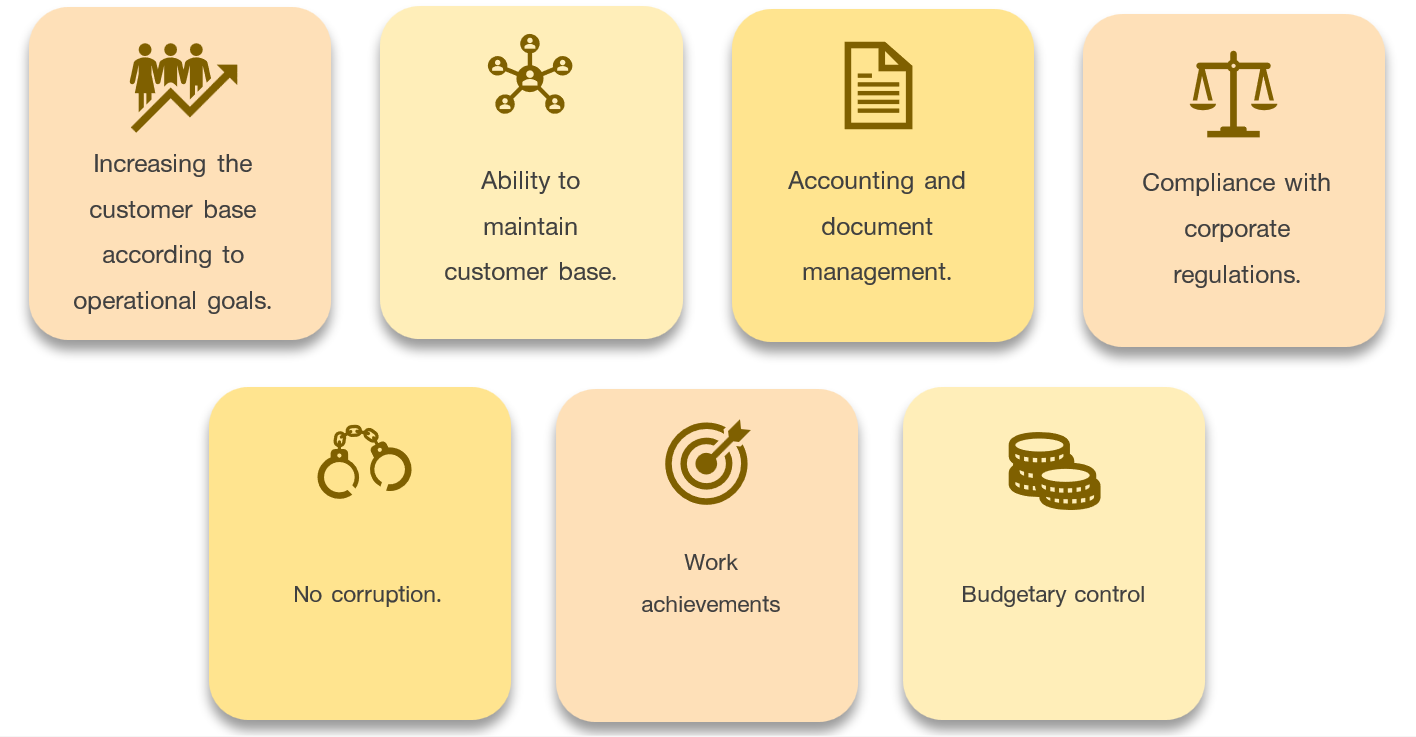
In terms of key performance indicators (KPIs), the company assesses them regularly at least once a year. The results of the assessment will be used as a criterion for considering salary adjustments for employees in the company.
6. MTC Employee Satisfaction
The company conducts an annual employee satisfaction survey. In 2023, the company surveyed 15,929 employees, and 11,146 employees responded, representing 69.97% of all employees. In 2024, the average employee satisfaction level was 85.29%, with satisfaction increasing in all aspects. The highest satisfaction was found in positive feedback towards colleagues and supervisors, with a satisfaction level of 89.63%. Following this was satisfaction in continuing to work with the company, with a level of 87.77%. The company set a satisfaction target of no less than 80%, which exceeded the set goal. However, in terms of work-life quality, the evaluation results were slightly below the standard. We will communicate these survey results to employees, acknowledge them, and develop operational processes to further improve employee satisfaction. This includes implementing projects to promote work-life quality for employees, conducting Growth Mindset training to enhance employees' understanding of their work, and organizing activities to relieve work-related stress, such as sports competitions and social gatherings, as opportunities arise.

Employee Engagement
Employee engagement is more important than employee satisfaction. A positive feeling towards the organization, love, trust, and acceptance of the organization's goals and values are key factors that bind employees to be willing to work effectively to achieve the organization's goals and to want to maintain their membership in the organization forever. In 2024, the level of employee engagement was 87.01%, which is higher than the previous year, and the employee turnover rate decreased from 12.06% in 2023 to 7.81%. This is due to the company's promotion of employee engagement activities, including organizing intra-district sports competitions, annual trips, employee training, collaborative work training, and various social gatherings on a regular basis.
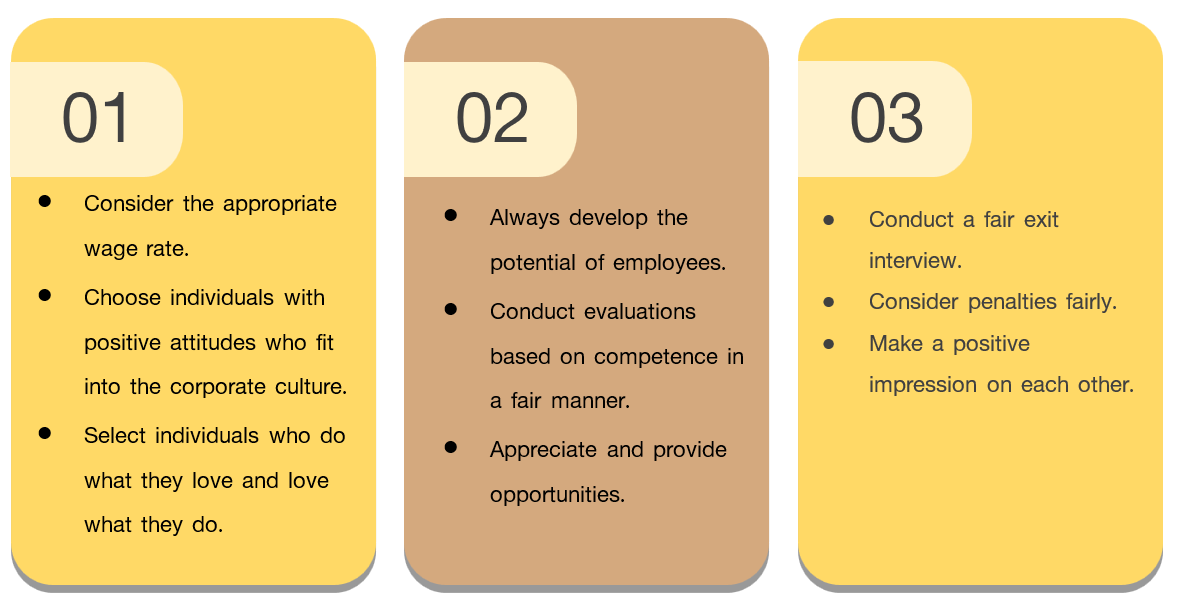
7. Employee Retention Measures (Labor Relations)
Since organizations have a diverse workforce, it is not surprising if conflicts arise between them, both in personal and work matters. To prevent or control such incidents and minimize their frequency, we prioritize building interpersonal relationships among employees. This is a crucial tool that fosters peaceful coexistence, generates motivation, and establishes teamwork as the foundation for efficient work. Our main measures are: to work in teams to create communication, cooperation, mutual assistance, intimacy, and unity within the team.


